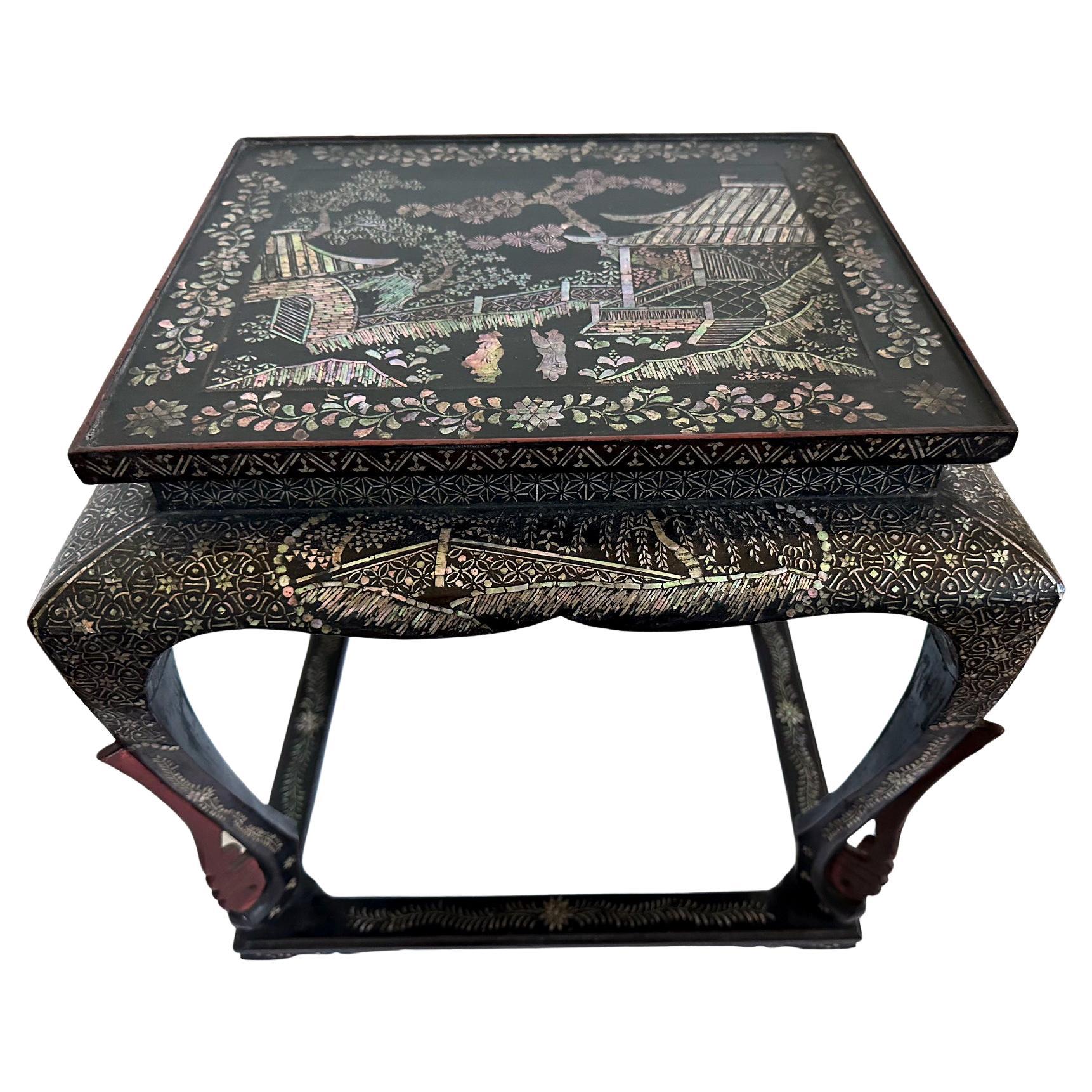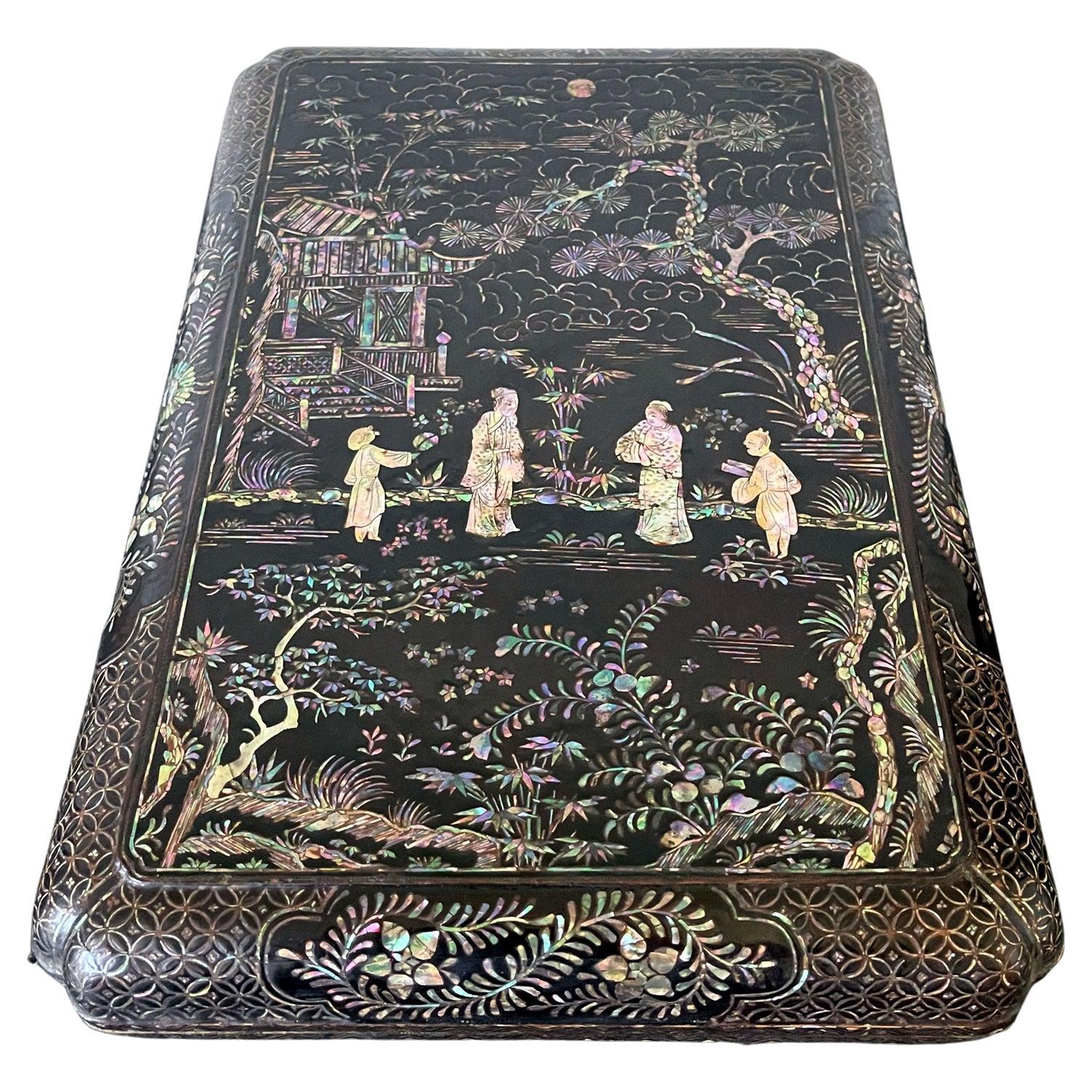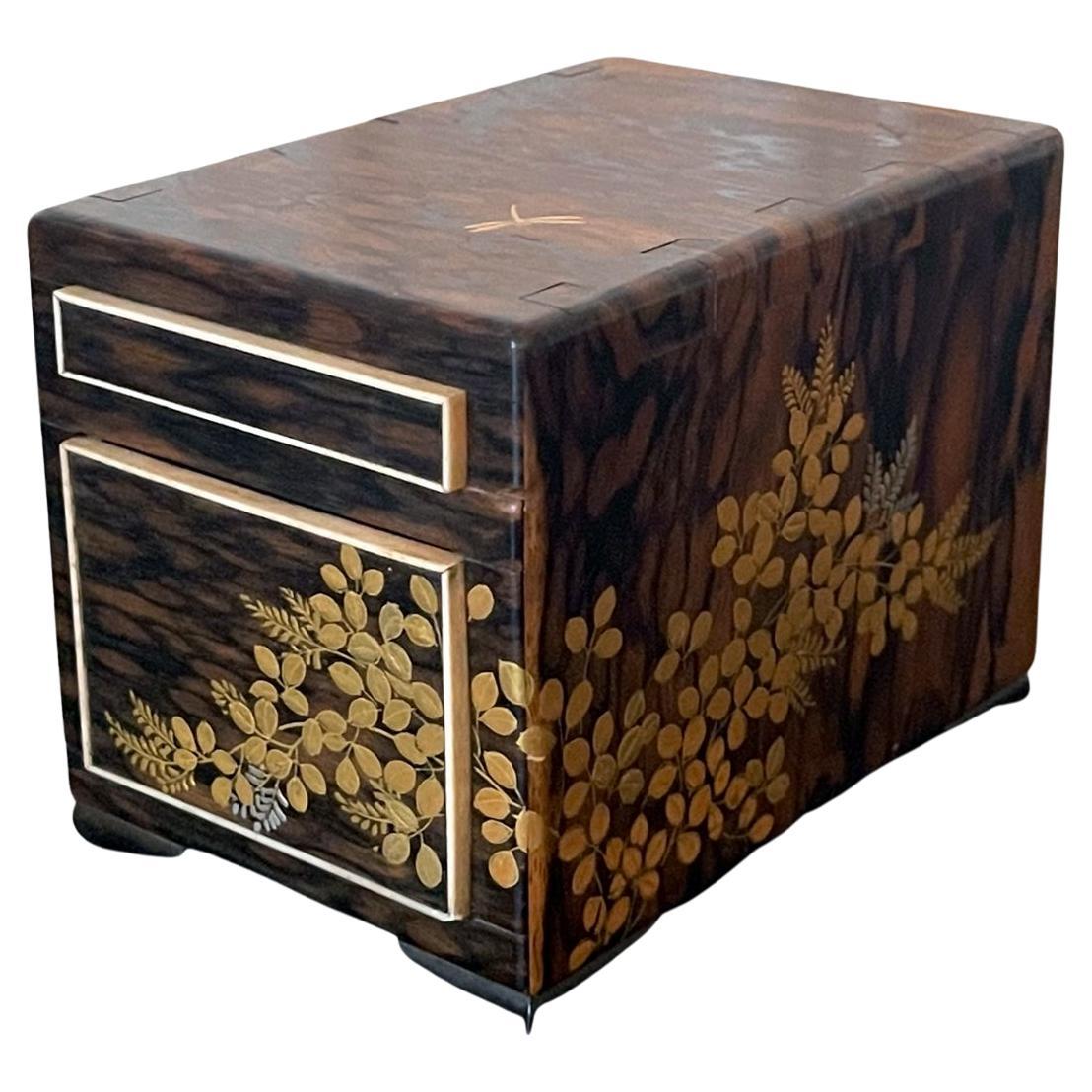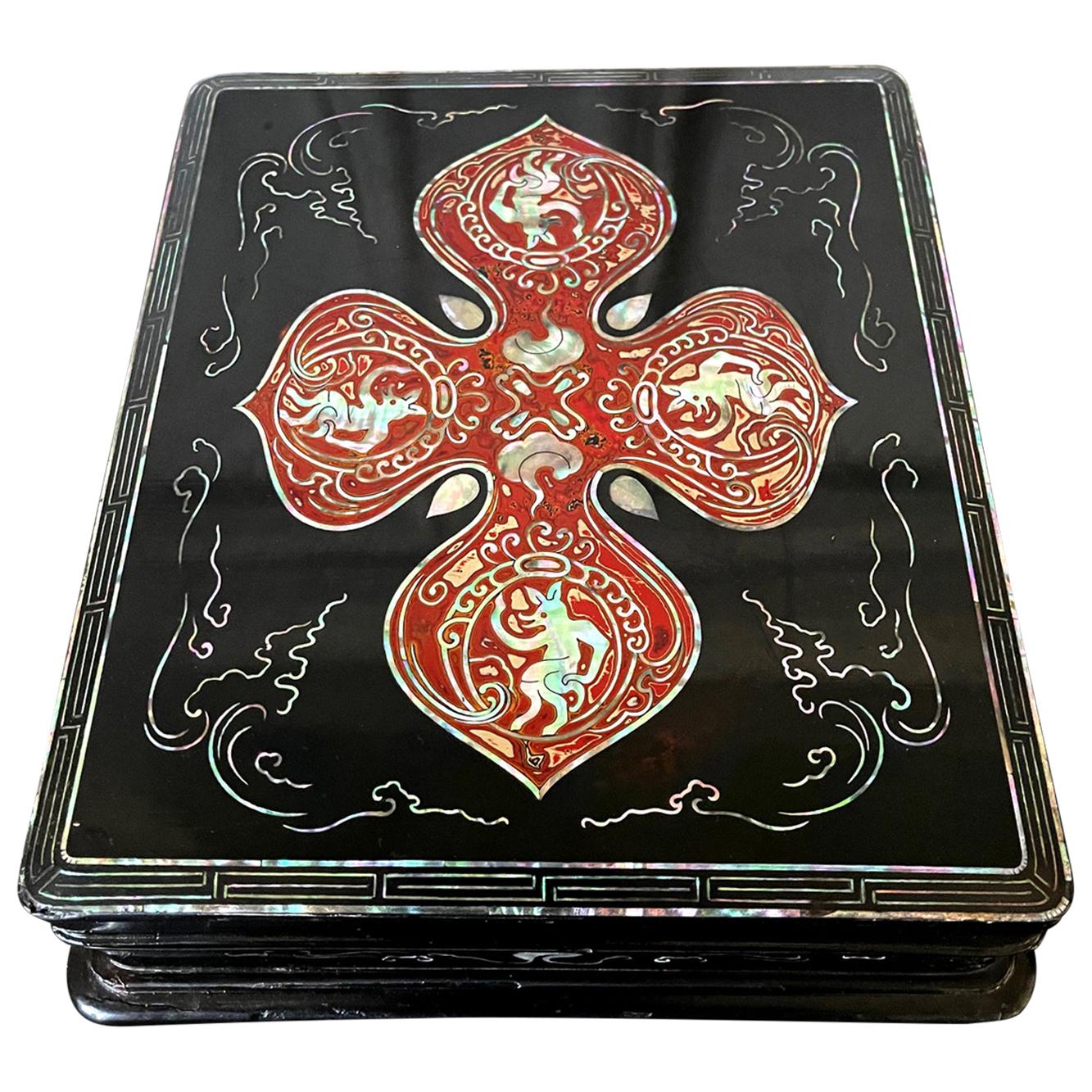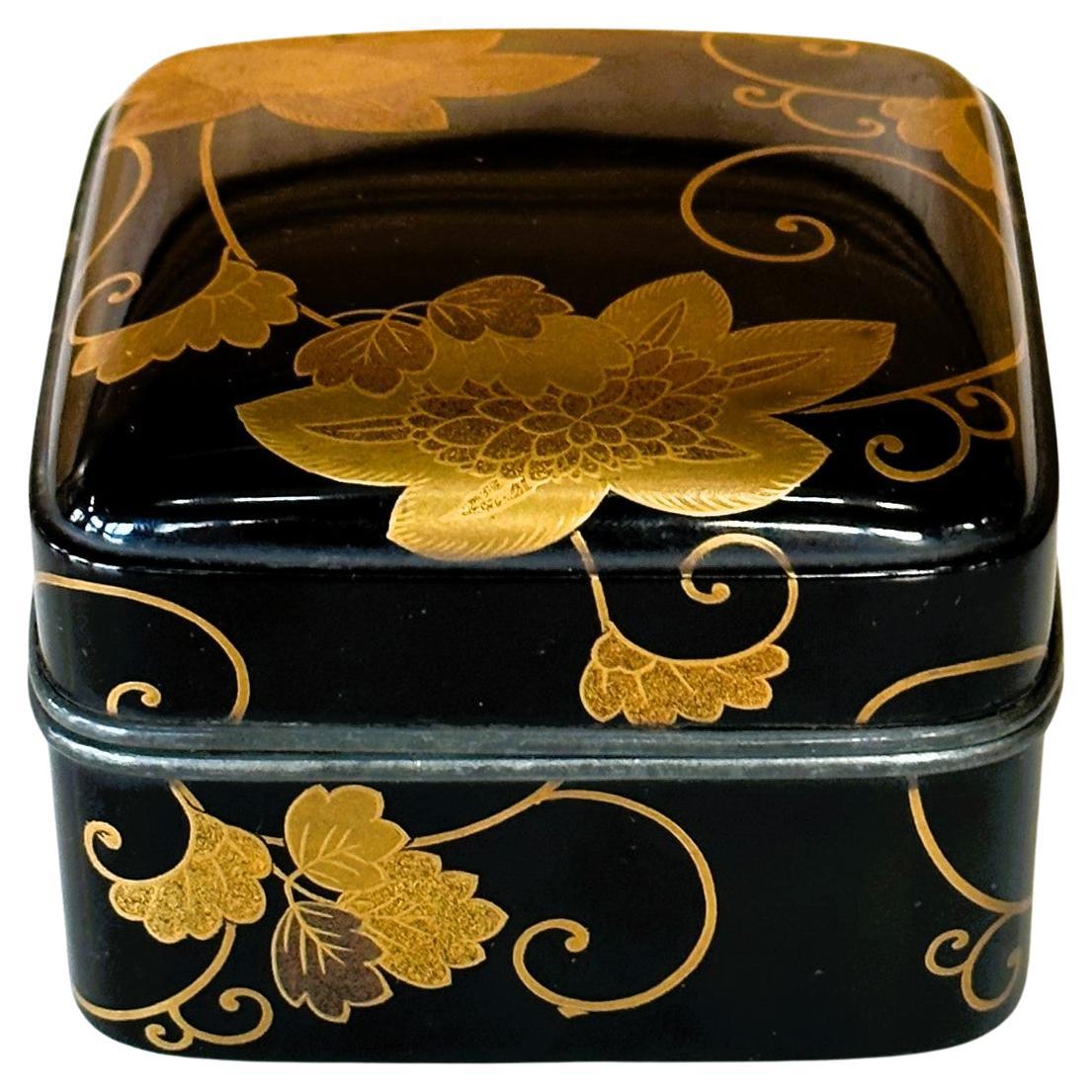Items Similar to Antique Japanese Lacquer and Inlay Kang Table from Ryukyu Island
Want more images or videos?
Request additional images or videos from the seller
1 of 21
Antique Japanese Lacquer and Inlay Kang Table from Ryukyu Island
About the Item
A small low table with lacquer and intricate mother-of-pearl inlay design from Ryukyu Islands kingdom circa 17-18th century. Ryukyuan kingdom was used to be an independent island country until it was officially annexed by Japan in 1879 during Meiji period and ultimately became Okinawa Prefecture. Its traditional lacquerware production and design was influenced by many surrounding cultures such as Chinese, Japanese, Korean and Southeast Asian and emerged as a distinct and style of its own. Gold paint on red lacquer background and extensive and fine workmanship of Raden shell inlays are two easily recognizable and iconic features of the Ryukyuan lacquerware.
The small rectangular table supported by apron and four short legs was traditionally used on bed or floor. Its origin was likely from the Chinese prototype of "Kang Table". The extensive inlay work on the top surface depicts a classic literary scene set on a stone terrace among the towering trees and undulating mounts and rocks in the garden. Two scholarly elders were opening and appreciating a scroll, attended by two young servants. This type of imagery became popular in China since Ming Dynasty. The apron and legs were also decorated with various inlay designs such as coin, scrolling vines and seeded grasses. The ball-shape legs were highlighted with red sidings, another character found in Ryukyuan lacquer table.
For reference on a similar table, see figure 94 in the Japanese version book "The Art of Ryukyuan Lacquerware" as shown in the last photo.
- Dimensions:Height: 5 in (12.7 cm)Width: 21 in (53.34 cm)Depth: 12.5 in (31.75 cm)
- Style:Edo (Of the Period)
- Materials and Techniques:
- Place of Origin:
- Period:
- Date of Manufacture:17-18th Century
- Condition:Wear consistent with age and use. Minor losses. Good antique condition with deep patina, scattered losses of individual inlays, slightly more on the apron due to handling, but they generally blend in well visually and give an antique ambience rather than condition issues.
- Seller Location:Atlanta, GA
- Reference Number:1stDibs: LU945038410532
About the Seller
5.0
Platinum Seller
These expertly vetted sellers are 1stDibs' most experienced sellers and are rated highest by our customers.
Established in 2006
1stDibs seller since 2010
479 sales on 1stDibs
Typical response time: <1 hour
- ShippingRetrieving quote...Ships From: Atlanta, GA
- Return PolicyA return for this item may be initiated within 2 days of delivery.
More From This SellerView All
- Antique Japanese Lacquer and Inlay Table from Ryukyu IslandsLocated in Atlanta, GAA small square-form table with lacquer and intricate mother-of-pearl inlay design from Ryukyu Islands kingdom circa 17-18th century. Ryukyuan kingdom was used to be an independent is...Category
Antique 18th Century Japanese Edo Lacquer
MaterialsMother-of-Pearl, Lacquer
- Antique Japanese Lacquer and Inlay Box from Ryukyu IslandLocated in Atlanta, GAA lacquer presentation box with mother-of-pearl inlays from Japanese Ryukyu Islands circa 17-18th century. The lidded box in rectangular form with rounded corner is a classic example...Category
Antique 18th Century Japanese Japonisme Lacquer
MaterialsMother-of-Pearl, Lacquer
- Fine Miniature Japanese Kodansu with Lacquer InlaysLocated in Atlanta, GAA fine Japanese miniature kodansu constructed from Kaki wood (Persimmon) circa 19th century, late Meiji period. With its expressive exotic wood grains and exposed tenon construction,...Category
Antique Late 19th Century Japanese Meiji Lacquer
MaterialsWood
- Fine Japanese Lacquered Inro with Inlays by KajikawaLocated in Atlanta, GAA Japanese four-case lacquer inro by a member of Kajikawa family circa 19th century (late Edo to early Meiji period). It depicts a nocturnal scenery of a meandering stream surrounded by bush clovers, where a full moon is reflected on the water. It was masterfully decorated in gold and silver maki-e using a combination of techniques including takamakie, togidashi and kirigane as well as aogai (abalone shell) inlays. The stream was set between the slightly elevated banks, adding to this piece a already strong three-dimensional composition. The interior was decorated in gold nashiji. It was signed on the bottom "Kajikawa Zou" (made by Kajikawa and a pot seal centered with "Ei" in Kanji. In one of the compartment, there is a katakana mark, appears to be a name, possibly the owner. Kajikawa clan was one of the most famous lacquer artisanal family established in the 17th century. Many well known members over the generations produced lacquer art in a wide range of formats, but two third were signed only with the family name such as this one. It is therefore not possible to pinpoint the exact author of this piece. Provenance: This inro was purchased as lot 349 in Christie's New York sale Japanese...Category
Antique 19th Century Japanese Japonisme Lacquer
MaterialsWood, Lacquer, Shell
- Unusual Japanese Lacquer Inkstone Box with MOP InlaysLocated in Atlanta, GAA Japanese black lacquer box with mother of pearl inlays circa early 20th century, end of Meiji period. It was likely to be used to store inkstone or other scholarly items. The piece displays several interesting characteristics that appear puzzling initially. First, the form is not typical Japanese, but more Chinese and Korean, with its scalloped base. Second, the decoration of MOP inlays also suggests a Korean and Chinese affiliation, especially with the linear borders and the scrolling cloud patters on the sides of the box. These two observations suggest that the box may be from Ryukyu Island instead of Japanese mainland. Third, strikingly in the center of the cover, a bold quarterly floral pattern outlined with MOP was filled with a striking mottled red lacquer using tsugaru nuri...Category
Early 20th Century Japanese Japonisme Lacquer
MaterialsWood, Lacquer
- Antique Japanese Lacquered Incense Box Kobako in Kodaiji StyleLocated in Atlanta, GAAn antique lacquered small box that was likely used to contain incense powder (it is called Kobako in Japanese), circa early to mid-19th century of the Edo...Category
Antique 19th Century Japanese Edo Lacquer
MaterialsWood, Lacquer
You May Also Like
- Antique Japanese Lacquer Stacking Food Box 'Jubako'Located in Hudson, NYWith all-over mother of pearl inlay and mon design of chrysanthemum in gold and black lacquer on top. The chrysanthemum is a national symbol of Japan and the Imperial family.Category
Antique 19th Century Japanese Lacquer
MaterialsGold
- Antique Japanese Dramatically Carved and Lacquered Stack Box on StandLocated in Hudson, NYAntique Japanese dramatically carved and lacquered stack box on stand. Meiji period (1868 - 1912) lacquer stacking box, traditionally used for bringing mochi (rice cake) to celebrati...Category
Antique Late 19th Century Japanese Meiji Lacquer
MaterialsLacquer
- Japanese Lacquer BoxLocated in New York, NYA Japanese red burgundy, gold and black lacquer box with round corners and silk cloth interior lining, circa early-20th century, 1920s, Japan. Box was desi...Category
Early 20th Century Japanese Decorative Boxes
MaterialsWood, Silk
- Antique Japanese Lacquer O-Bento Box with Gold and Silver Maki-E DecorationLocated in Prahran, VictoriaAn unusual hexagonally shaped antique Japanese three-tiered o-bento box with a carrying tray decorated with a classical Rimpa style gold and silver Maki-e lacquer design of gently sw...Category
Antique Early 1900s Japanese Meiji Lacquer
MaterialsLacquer, Wood
- Japanese Momoyama Period Black Lacquer and Mother of Pearl Box, 16th CenturyLocated in Austin, TXA fine and unusual Japanese black lacquer and mother of pearl inlaid box, Momoyama Period, 16th century, Japan. The large box and cover featu...Category
Antique 16th Century Japanese Edo Lacquer
MaterialsAbalone, Lacquer
- Fine Japanese Namban Lacquer Jewelry Casket, 17th CenturyLocated in Amsterdam, NLJapanese Namban lacquer transition-style coffer with two drawers Kyoto/Nagasaki, circa 1650 The cartouches with gilt and red decorations of leaves...Category
Antique 17th Century Japanese Edo Lacquer
MaterialsCypress
Recently Viewed
View AllMore Ways To Browse
Ming Dynasty Pearl
Mother Of Pearl Inlay Bed
Red Lacquered Furniture
Sake Ewer
Art Deco Onlay
Takasago Couple
Lacca Giapponese
Gold Leaf Carved Wall
Midcentury Cane Table
Vase With Bronze Glass
Murano Vase In Red
Vintage Green Turkish Oushak Rug
28 High Table
Red Enamel Vase
German Opaline Glass
Milo Baughman Seat
Table With Tripod Legs
Mid Century Paolo Buffa
